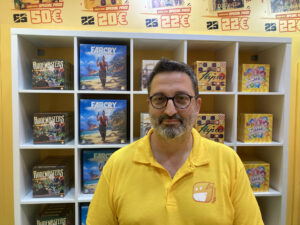
“You can run a $1.5m campaign and end up with a net loss of $1m”: Why math, math, math has been key to Dux Somnium’s blossoming board game Kickstarters
Raising $1m in crowdfunding for a board game is no mean feat, even for veteran publishers with multiple campaigns under their belts. But high school sweethearts Dusty and Amy Droz managed just that last year on their first try, after more than 15,000 backers pledged funding to create Victorian-themed flower hunting game Botany. Amid juggling their wedding photograph business and managing their own lavender farm, Dusty spoke to BoardGameWire about how the lessons learned from their crowdfunding debut helped Dux Somnium score its second success in raising $550,000 for follow-up game La Fleur.
Did you always intend La Fleur to be another crowdfunding project following the success of Botany, or did you consider going straight to a publisher this time around?
We have three other businesses that we own, so we have always planned to self-publish our own games. We were fortunate enough with Botany to break the crowdfunding treadmill and have the on-hand funds to produce La Fleur without crowdfunding if needed, but we really like how crowdfunding gives us a bit of an indicator of demand (even if it’s not 1 to 1 with what retail and e-comm demand will look like) and the massive amount of marketing uplift that it gives us. La Fleur’s campaign has just ended, but we’re already working toward the launch of our next two games after it, and we’ll be evaluating each of those for whether to start with crowdfunding or take them straight to market.
How important was the pre-launch period for getting this campaign to shine? What strategies did you use to raise awareness, what had the greatest impact, and what didn’t really work?

Our pre-campaign marketing with LaunchBoom has absolutely been a major key to the success of both games! We created a mini expansion for both games that we offered on sale for $1 before the campaign to create some fun additional content for our fans and help us get the word out and generate excitement. We sold 2,550 of those mini expansions for Botany and 3,300 for La Fleur, and generated an additional 11,000 emails for our marketing list beyond those sales as well. Our day one conversion rate on all our fans who purchased those mini expansions was around 40% for both campaigns, with even more of them converting to pledges as both campaigns progressed. We coupled that work with LaunchBoom with also engaging our fans on Facebook and Instagram, and between the two of those things we have been extremely happy with the community we have built!
In what ways did you approach this Kickstarter differently compared to your previous crowdfunding campaign? And why?
We found that the live campaign ads for La Fleur weren’t working at nearly as high a ROAS (return on ad spend) as our ads for Botany, despite all our other conversion metrics in every other part of the Kickstarter campaign being extremely good. There were a hundred reasons why that might be happening, but no real data to support any of them, so rather than get stuck on that, we decided to get clever with our marketing efforts. We developed a few different marketing initiatives to increase our social media presence and engagement and also bring in more returning backers, and we found a ton of success with those.
What was happening with the ROAS on our Meta ads forced us to get creative and come up with other ways to generate buzz. We wanted to do so in a way that would be really fun for our fans, so the first idea we came up with was to offer a giveaway for a trip to Paris! That kind of promotion is really on brand for our style of historical games, but I genuinely would not recommend that most companies try it. Unsurprisingly, it turns out that giving away a prize like that is massively regulated by the federal and state governments and there are all kinds of tax implications and hoops to jump through. We managed to navigate all those things, and the result has been really successful.
To date our announcement video on Instagram has been viewed 322,000 times, we’ve gained 5,300 new Instagram followers, and the campaign has generated enough direct sales to more than pay for itself. The second thing we did was create a promotion for all our returning backers as a way to say thank you to them for supporting our games. We have been working on Botany’s new Orchid Obsession expansion, and we decided that anyone who owns Botany and backs La Fleur would get that expansion as a gift from us for free. In the two weeks we’ve been running that promotion we have doubled the number of returning backers that we had, and we have received a massive number of emails and comments from our fans about how excited they are for it.
How did you come up with your goal amount, and what were your minimum / maximum expectations going into the campaign?

Math, math, and math! We look at our goals as a series of benchmarks. The first is the minimum amount of money that we need in order to get the campaign off the ground, knowing that if we hit that amount we would then be able to pull money from other sources available to us (operating cash for the business, our own savings, etc). In the case of both Botany and La Fleur, that amount was $5,000, and that’s what we set our campaign goal to. The next internal goal is the amount that we would need to hit our minimum order quantity to print each game and get it to our fulfillment centers. Once we pass that, our next internal goal after that is covering the production costs plus development of the game and the cost of our pre-campaign marketing, effectively meaning that we had broken even on the project. We hit that mark with Botany about two hours after launching, and with La Fleur (we were actually paying closer attention this time around) we hit that mark in 67 minutes. After that point in the campaign, all our investments are recouped, production is covered, and we’re developing our ROI from that point forward.
What was your strategy with stretch goals and add-ons for this campaign, and do you think it’s had a positive impact? Would you approach it differently if you were to run the campaign again?
I have such a controversial opinion about this. I think stretch goals are mostly not used in the true spirit of stretch goals, and I pretty firmly believe that almost nobody who is on the fence about backing your project decides to go for it based on what they see in the stretch goals. My guess is that it’s literally tens of backers at most, if that. I think a true stretch goal is a revenue point that you absolutely must hit in order to be able to make something specific happen. I have a friend who needed to hit X amount of dollars on his campaign in order to have the extra funds to create an expansion for his game that he would then be able to add as an add-on on that same campaign. That is a real stretch goal, but the negative comments from backers over that stretch goal would just come in floods if he did that.
I also think that stretch goals are a very dangerous place to create project creep, introduce unforeseen cost increases in the unit cost of your project, and mess up your shipping calculations. For La Fleur, we knew already that we just wanted to include all the nice things that are often made stretch goals (linen finishes, foil on the box, custom pawns, etc), so we just called those pre-stretched. Then, for fun, we created another mini expansion that all our Kickstarter backers would get for free, and everytime we hit one of our stretch goals we added more cards to that mini expansion. That made our stretch goals their own completely isolated product, made it so we don’t have to create multiple versions of the base game for Kickstarter and retail, and will enable us to sell that mini expansion through our website at regular retail price going forward so anyone who missed out on the Kickstarter can still get it later if they like.
Knowing what you know now, what else might you have approached differently either before or during the campaign?
Given the result of our Meta ads, we would have started our other marketing initiatives sooner in the campaign. That, though, was based on so many factors outside our control, that I have no idea how we could have possibly anticipated it. La Fleur’s project has been such a wild success for us that I might just be Monday morning quarterbacking myself to see how I could make it incrementally better on this one, but that doesn’t stop us from constantly trying to make everything we do 1% better.
How about post-campaign production and fulfillment – are the manufacturing delays and supply chain problems post-Covid now over, or are they still having an impact?

We have been really fortunate not to hit any big snags! Our manufacturer, Panda, is absolutely phenomenal, and they are so quick and efficient at everything they do. The only hiccup we had with Botany’s fulfillment was our ship to the UK/EU had to take a left turn around Africa to avoid the Red Sea, but otherwise everything ran incredibly smoothly. I am a disaster planner, so I have backup plans for my backup plans and don’t count my chickens until they hatch, so we are going to continue to remain vigilant in our planning for La Fleur’s production and fulfillment, too.
What about increased costs of materials, shipping, etc – how have those affected your approach to this campaign?
This one all comes back to the math again as well. We make sure we know every cost going into our games and the logistics surrounding them before we launch the campaign. We know what we want the price point to be and have a rough idea of our superfan’s price expectations as well, so all our games are designed with that in mind from the moment we start creating them. Since we know where we want to be from the very beginning, that makes it really easy for us to figure out what levers to pull and what things to include or exclude from our games to ensure that our profit margin is always where we need it to be to keep the company healthy and running well. We also work really hard to make sure we always have sufficient operating cash on hand for emergencies, which leads right back into the previous question. If we suddenly find out that shipping is going to be more expensive, we unexpectedly need to do a reprint sooner than anticipated, or any one of a hundred other possible sudden expenses, we have that safety net built into our business to make sure that we can cover those when they arise.
How would you describe the general consumer appetite for crowdfunded games currently, and how have you seen that change over time? Is the crowdfunding market becoming more competitive?
I think this question is above my paygrade! Amy and I have a fanbase that is very much not a core Kickstarter user. Botany brought in over 3,000 first-time backers to Kickstarter and La Fleur is over 500 first-time backers. We create light games that we like to think are a great entry point into strategy gaming, so in regular retail the majority percentage of our customers are also folks who are not super familiar with crowdfunding in general. Overall, though, I think just browsing through Kickstarter tells you that the appetite is massive for crowdfunded games, and the community seems to be going strong with no sign of stopping.
What are your essential tips for anyone about to launch their own board game crowdfunding campaign? And what are the biggest pitfalls and traps you see board game crowdfunders fall into?
You might have gleaned this from my previous answers already, but this one is math, math, and math again! Know every cost going into the development, production, marketing, and sales of your campaign. Talk to all your vendors and run your math by them, too. Do the math eight times and then ask everyone you know to check the math for you. You should know going into your campaign exactly how much everything is going to cost, exactly what your ROI will be at various levels of revenue, how much operating cash you have on hand at any given time in case of emergencies, the works.
Everyone focuses on the amount of money raised as an indicator of success, but you can run a $1.5m campaign and end up with a net loss of $1m, and you can run a $50,000 campaign and end up with $25,000 profit and a 200% ROI. Unless it makes the news, backers and the industry at large don’t see the actual results. I know exactly which of those two scenarios I would rather be as a business.





